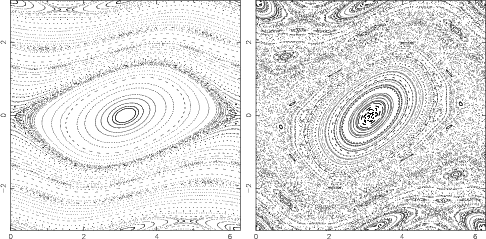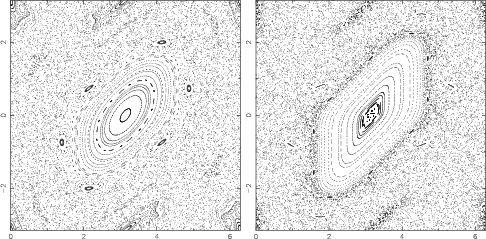A 2-D Map, also called the Taylor-Greene-Chirikov Map in some of the older literature.
where  and
and  are computed mod
are computed mod  and
and  is a Positive constant. An analytic estimate of the width of the
Chaotic zone (Chirikov 1979) finds
is a Positive constant. An analytic estimate of the width of the
Chaotic zone (Chirikov 1979) finds
 |
(3) |
Numerical experiments give  and
and  . The value of
. The value of  at
which global Chaos occurs has been bounded by various authors.
Greene's Method is the most accurate method so far devised.
at
which global Chaos occurs has been bounded by various authors.
Greene's Method is the most accurate method so far devised.
| Author |
Bound |
Fraction |
Decimal |
| Hermann |
 |
 |
0.029411764 |
| Italians |
 |
- |
0.65 |
| Greene |
 |
- |
0.971635406 |
| MacKay and Pearson |
 |
 |
0.984375000 |
| Mather |
 |
 |
1.333333333 |
Fixed Points are found by requiring that
The first gives
 , so
, so
 and
and
 |
(6) |
The second requirement gives
 |
(7) |
The Fixed Points are therefore
 and
and  . In order to perform a
Linear Stability analysis, take differentials of the variables
. In order to perform a
Linear Stability analysis, take differentials of the variables
In Matrix form,
![\begin{displaymath}
\left[{\matrix{
\delta I_{n+1}\cr \delta\theta_{n+1}\cr}}\r...
...ght]\left[{\matrix{\delta I_n\cr \delta \theta_n \cr}}\right].
\end{displaymath}](s3_535.gif) |
(10) |
The Eigenvalues are found by solving the Characteristic Equation
 |
(11) |
so
 |
(12) |
![\begin{displaymath}
\lambda_\pm = {\textstyle{1\over 2}}[K\cos\theta_n+2\pm\sqrt{(K\cos\theta_n+2)^2-4}\,].
\end{displaymath}](s3_538.gif) |
(13) |
For the Fixed Point  ,
,
The Fixed Point will be stable if
 Here, that means
Here, that means
 |
(15) |
 |
(16) |
 |
(17) |
 |
(18) |
so  . For the Fixed Point (0, 0), the Eigenvalues are
. For the Fixed Point (0, 0), the Eigenvalues are
If the map is unstable for the larger Eigenvalue, it is unstable. Therefore,
examine
 . We have
. We have
 |
(20) |
so
 |
(21) |
 |
(22) |
But  , so the second part of the inequality cannot be true. Therefore, the map is unstable at the Fixed
Point (0, 0).
, so the second part of the inequality cannot be true. Therefore, the map is unstable at the Fixed
Point (0, 0).
References
Chirikov, B. V. ``A Universal Instability of Many-Dimensional Oscillator Systems.'' Phys. Rep. 52,
264-379, 1979.
© 1996-9 Eric W. Weisstein
1999-05-26

